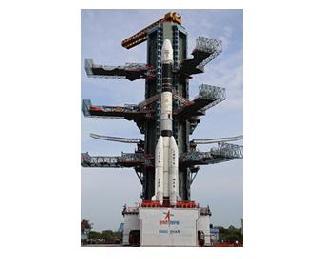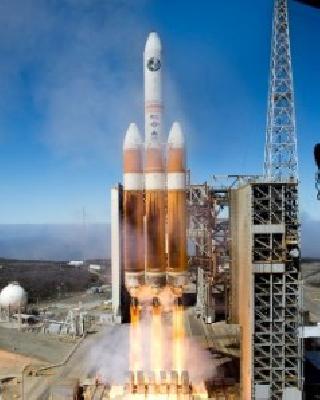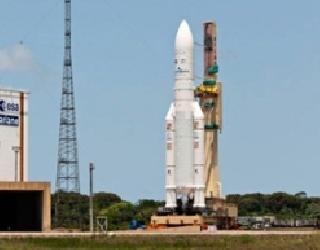
The GSLV-D5 rocket at launch pad. A file photo
BANGALORE (PTI): The flight-test of GSLV with indigenous cryogenic engine, called off ten days ago following a leak in the second stage of the rocket, is now expected to take place only in December, Indian Space Research Organisation (ISRO) said on Wednesday.
ISRO has started the process of de-stacking the rocket and the second stage would be shifted to Liquid Propulsion Systems Centre (LPSC), a facility of the space agency located at Mahendragiri in Tamil Nadu, for an investigation into the cause of the leakage.
The launch of the GSLV-D5, scheduled for 1650 hrs on August 19 from the Sriharikota spaceport was called off, as a leak was observed in the UH25 fuel system of the liquid second stage during the pre-launch pressurisation phase on the vehicle just two hours before the scheduled lift-off.
The propellants were later drained from the cryogenic stage, liquid second stage and the four liquid strap-ons of the GSLV-D5. The rocket was moved back to the vehicle assembly building.
An ISRO official told PTI here that the first and third stage of GSLV would be "preserved" while the second stage would have to be built again, a process which has already started.
ISRO would be busy with the Mars Orbiter mission in the next two months. "We can expect the GSLV flight in December", the official said.
ISRO has drawn flak from some quarters for using an "old tank" for the second stage as the materials used for building it were "prone for delayed cracks". It was said to have been delivered to ISRO four-years ago and was to be the last in the series of the kind that ISRO planned to use.
A senior space scientist called it a "gross error of judgement" on the part of ISRO which obviously seemed to focus more on the third (cryogenic) stage, as the first two were a "given" as it's similar to the proven PSLV - the workhorse launcher.
GSLV is a three stage vehicle that is 49 metre tall, with 414 tonne lift-off weight. First stage comprises S125 solid booster with four liquid (L40) strap-ons. Second stage (GS2) is liquid engine and the third stage (GS3) is a cryostage.
The final/third stage of GSLV is the cryogenic stage, which is more efficient compared to the liquid stage in PSLV.
This means that the thrust developed by burning each kg of propellant is higher in cryo engine, hence can place larger payloads with higher weight into orbit.
"Cryo stage as final stage is hence essential for a launcher with higher payload capacity", an ISRO official said.
PSLV is capable of launching 1600 kg satellites in 620 km sun-synchronous polar orbit and 1050 kg satellite in geo-synchronous transfer orbit (GTO).
"This poses a serious limitation on launching communication satellites which are heavier. The GSLV will be capable of launching satellites which are 2000 kg- 2500kg which matches with the GSAT class of Communication satellites", it was noted.
Currently, India is forced to outsource the launch services from abroad which are not a cost effective solution, and the establishment of a proven GSLV launcher is the need of the hour. The successful development of indigenous cryo stage will boost India's confidence in terms of its self-reliance in the launch capability, ISRO officials said.
 Previous Article
Previous Article Next Article
Next Article













The Indian Air Force, in its flight trials evaluation report submitted before the Defence Ministry l..
view articleAn insight into the Medium Multi-Role Combat Aircraft competition...
view articleSky enthusiasts can now spot the International Space Station (ISS) commanded by Indian-American astr..
view article